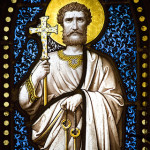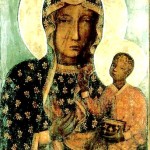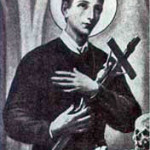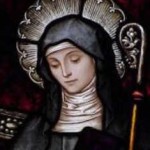Peace be with you my friends! Today I would like to continue my series of articles on the history and practices of Voodoo is both Haiti and New Orleans. Today's installment focuses on the Lwa. Again, I will say that I am not an Hougan and that my expertise is in New Orleans Voodoo and not Haitian Vodou, so I do apologize for any errors regarding the practice of Vodou in Haiti. Please share any of your knowledge in the comments section.
The lwa, a term that comes from the French word loi meaning law, as each spirit represents a law of nature or of the human condition.
The Voodooist serves a pantheon of spirits called the “lwa,” a term that comes from the French word “loi” meaning “law” as each spirit represents a law of nature or of the human condition. The lwa are divided into three major nations. The first is the Rada nation. These are the original lwa and came from African during the early days of colonization. The second is the “petro” nation which is comprised of fiery, volatile spirits born during the Haitian Revolution in which Vodou played a fundamental role in overthrowing French colonial rule. Most Rada lwa have a petro counterpart. The third is the “ghede” nation which represents the spirits of the dead and death itself, which every Voodooist knows is simply a passage from one state to being to another and nothing to be feared. It is my pleasure to share with you some information about a few of the lwa with you today.
 Papa Legba-Legba is a lwa of the Rada family. He is the lwa to which one must appeal before invoking any other lwa or performing any act of Voodoo magic, since he holds the keys to the spirit world and stands at the gateway between the physical world and the realm of the lwa and nobody may pass without his permission. Legba’s offerings include tobacco, rum, black eyed peas, spiced chicken and his sacrificial animals are roosters and goats. He is syncretized with Saint Peter, who in Catholic iconography holds the keys to Heaven.
Papa Legba-Legba is a lwa of the Rada family. He is the lwa to which one must appeal before invoking any other lwa or performing any act of Voodoo magic, since he holds the keys to the spirit world and stands at the gateway between the physical world and the realm of the lwa and nobody may pass without his permission. Legba’s offerings include tobacco, rum, black eyed peas, spiced chicken and his sacrificial animals are roosters and goats. He is syncretized with Saint Peter, who in Catholic iconography holds the keys to Heaven.
![Mater Dolorosa [Our Lady of Sorrows] is the catholic counterpart to the Lwa Ezili Freda Mater Dolorosa [Our Lady of Sorrows] is the catholic counterpart to the Lwa Ezili Freda](https://jamesduvalier.com/wp-content/uploads/2013/08/eili-freda-mater-dolorosa-150x150.jpg) Erzulie Freda Dahomey-Erzulie belongs to the Rada family of lwa. She is the mistress who rules in the domain of love and wealth. One might petition Erzulie to bring about a change in one’s financial situation or to attract a lover. Be warned though, that love brought by Erzulie rarely lasts, as she tends to confer upon her devotees brief, albeit passionate and erotic, affairs. She is flirtatious, volatile, passionate and capricious. She also speaks French, which is seen as both a sign of refinement and arrogance in Haiti. There is a saying in Haitian Creole, “parle franse pa fe lespri pou sa,” speaking French doesn’t make you smart. Her colors are pink and light blue and her favorite offerings include champagne, sweet cakes, flowers, perfume and white doves. Typically, when Erzulie possesses one of her devotees during a Voodoo ceremony, she often departs crying, since there are never enough luxurious items to satisfy her desires. She is syncretized with the Mater Dolorosa of the Catholic faith.
Erzulie Freda Dahomey-Erzulie belongs to the Rada family of lwa. She is the mistress who rules in the domain of love and wealth. One might petition Erzulie to bring about a change in one’s financial situation or to attract a lover. Be warned though, that love brought by Erzulie rarely lasts, as she tends to confer upon her devotees brief, albeit passionate and erotic, affairs. She is flirtatious, volatile, passionate and capricious. She also speaks French, which is seen as both a sign of refinement and arrogance in Haiti. There is a saying in Haitian Creole, “parle franse pa fe lespri pou sa,” speaking French doesn’t make you smart. Her colors are pink and light blue and her favorite offerings include champagne, sweet cakes, flowers, perfume and white doves. Typically, when Erzulie possesses one of her devotees during a Voodoo ceremony, she often departs crying, since there are never enough luxurious items to satisfy her desires. She is syncretized with the Mater Dolorosa of the Catholic faith.
 Madame La Sirène-La sirène is of the Rada family and she is the mistress of the sea. While Erzulie embodies the sensual aspects of femininity, la Sirène represents the maternal and nurturing side of womanhood. She is also a fierce protector of those who fall under her patronage. A legend told around Port-au-Prince speaks of a Protestant pastor and politician during the 1940’s who spoke out against Vodou and personally targeted a well known mambo who was a child of La Sirène. In front of a crowed on the beach, he publicly harangued the priestess and her practices and out of nowhere, a massive wave rolled onto shore on top of which stood a regal woman in an elegant blue dress, which everyone knew was La Sirène. She wrapped her arms around the man and dragged him back to into the ocean with well over a hundred witnesses. He resurfaced in Port-au-Prince seven years later and when people exclaimed that they thought surely he was dead, he responded “il aurait vallu mieux que je le fusse,” it would have been better if I had been, as he clamed to have been a prisoner of the La Sirène, his soul held captive in her under sea realm. Whether anything remotely resembling this story occurred or not cannot be known for sure, but the moral is that those who defame the lwa and their children will not go unpunished, which again lends credence to the idea that Vodou is a religion of survival and empowerment. La Sirène’s offerings include honey, wine and sweet cakes. She is often depicted as a mermaid, since this is meaning of Sirène in French, but she is also syncretized with the Stella Maris, or Star of the Ocean, which is one of the many titles of the Blessed Virgin Mary.
Madame La Sirène-La sirène is of the Rada family and she is the mistress of the sea. While Erzulie embodies the sensual aspects of femininity, la Sirène represents the maternal and nurturing side of womanhood. She is also a fierce protector of those who fall under her patronage. A legend told around Port-au-Prince speaks of a Protestant pastor and politician during the 1940’s who spoke out against Vodou and personally targeted a well known mambo who was a child of La Sirène. In front of a crowed on the beach, he publicly harangued the priestess and her practices and out of nowhere, a massive wave rolled onto shore on top of which stood a regal woman in an elegant blue dress, which everyone knew was La Sirène. She wrapped her arms around the man and dragged him back to into the ocean with well over a hundred witnesses. He resurfaced in Port-au-Prince seven years later and when people exclaimed that they thought surely he was dead, he responded “il aurait vallu mieux que je le fusse,” it would have been better if I had been, as he clamed to have been a prisoner of the La Sirène, his soul held captive in her under sea realm. Whether anything remotely resembling this story occurred or not cannot be known for sure, but the moral is that those who defame the lwa and their children will not go unpunished, which again lends credence to the idea that Vodou is a religion of survival and empowerment. La Sirène’s offerings include honey, wine and sweet cakes. She is often depicted as a mermaid, since this is meaning of Sirène in French, but she is also syncretized with the Stella Maris, or Star of the Ocean, which is one of the many titles of the Blessed Virgin Mary.
 Erzulie Dantor-Erzulie Dantor is the Petro aspect of Erzulie Freda and is one of the fiery, vengeful spirits born during the struggle for independence. She is invoked to punish an abusive lover or somebody who deeply hurt one of her children. In Haiti, which is still an excessively machista society, men can often beat and violate women without any consequences and there have been many instances where men have been mysteriously driven to suicide after mistreating a child of Erzulie Dantor, and she has therefore gained the reputation of defender of women and children. Her offerings include “kleren”, a fiery drink made by infusing hot peppers with rum, rice and peas and her sacrificial animal is the wild Creole pig, which is difficult to find in Haiti due to an American sponsored eradication program during the 1930’s, so a common black pig is often substituted. Erzulie Dantor is syncretized with Our Lady of Czestochowa, a black Madonna of Polish origin. The story behind this association is that in an attempt to suppress the Haitian slave rebellions, the French government hired Polish mercenaries who upon seeing the harsh conditions to which the slaves were subjected, sided with the rebelling slaves and helped overthrow French colonial rule. Our Lady of Czestochowa is depicted as a protective mother with a scared face clutching her child in her arms. When the slaves saw the Polish soldiers carrying this icon into battle, they immediately recognized in her battered features and warrior spirit their own Erzulie Dantor and they knew that they could trust the Polish mercenaries since Dantor herself had sent them. To this day, Voodooists use the image of the Polish Madonna in services to Erzulie Dantor, which is proof again of the syncretic and ever evolving nature of Vodou.
Erzulie Dantor-Erzulie Dantor is the Petro aspect of Erzulie Freda and is one of the fiery, vengeful spirits born during the struggle for independence. She is invoked to punish an abusive lover or somebody who deeply hurt one of her children. In Haiti, which is still an excessively machista society, men can often beat and violate women without any consequences and there have been many instances where men have been mysteriously driven to suicide after mistreating a child of Erzulie Dantor, and she has therefore gained the reputation of defender of women and children. Her offerings include “kleren”, a fiery drink made by infusing hot peppers with rum, rice and peas and her sacrificial animal is the wild Creole pig, which is difficult to find in Haiti due to an American sponsored eradication program during the 1930’s, so a common black pig is often substituted. Erzulie Dantor is syncretized with Our Lady of Czestochowa, a black Madonna of Polish origin. The story behind this association is that in an attempt to suppress the Haitian slave rebellions, the French government hired Polish mercenaries who upon seeing the harsh conditions to which the slaves were subjected, sided with the rebelling slaves and helped overthrow French colonial rule. Our Lady of Czestochowa is depicted as a protective mother with a scared face clutching her child in her arms. When the slaves saw the Polish soldiers carrying this icon into battle, they immediately recognized in her battered features and warrior spirit their own Erzulie Dantor and they knew that they could trust the Polish mercenaries since Dantor herself had sent them. To this day, Voodooists use the image of the Polish Madonna in services to Erzulie Dantor, which is proof again of the syncretic and ever evolving nature of Vodou.
 Baron Samedi-Baron Samedi is the king of the Ghede lwa and functions much in the same way with the dead as Legba does among the lwa, since anyone who wishes to invoke the help of the dead must first appeal to Baron to open the gate between the world of the living and of the dead. In Haiti, the grave of the first man buried in a cemetery is consecrated to Baron Samedi and a large cross is erected at which Voodooists may place offerings to Baron. Baron has many manifestations, the most popular being Baron LaCroix, Baron Cimitiere and Carrefour. They are however all aspects of the same lwa who is invoked under different titles for different purposes. This lwa of death is often depicted as a tall, smiling skeleton that is dressed like an undertaker complete with a stovepipe hat. His mocking appearance is meant to poke fun at death, an inevitability for us all. When Baron, or any Ghede lwa, possesses on of his followers, the mounted Voodooist will often be compelled to perform a suggestive dance called the “banda” which is characterized by spasmodic pelvic thrusts. Perhaps because of his aggressive, carnal nature, Baron is know as the lwa of fertility and is often invoked by women who wish to conceive a child, especially a son. His offerings include kleren, spiced pork, cigars, candies and “pois djon djon”, a heavily seasoned rice and mushroom dish. His sacrificial animal is a rooster or a black goat and his Catholic counterpart is Saint Gerard Mejilla, although in New Orleans he is closely associated with Saint Expedite.
Baron Samedi-Baron Samedi is the king of the Ghede lwa and functions much in the same way with the dead as Legba does among the lwa, since anyone who wishes to invoke the help of the dead must first appeal to Baron to open the gate between the world of the living and of the dead. In Haiti, the grave of the first man buried in a cemetery is consecrated to Baron Samedi and a large cross is erected at which Voodooists may place offerings to Baron. Baron has many manifestations, the most popular being Baron LaCroix, Baron Cimitiere and Carrefour. They are however all aspects of the same lwa who is invoked under different titles for different purposes. This lwa of death is often depicted as a tall, smiling skeleton that is dressed like an undertaker complete with a stovepipe hat. His mocking appearance is meant to poke fun at death, an inevitability for us all. When Baron, or any Ghede lwa, possesses on of his followers, the mounted Voodooist will often be compelled to perform a suggestive dance called the “banda” which is characterized by spasmodic pelvic thrusts. Perhaps because of his aggressive, carnal nature, Baron is know as the lwa of fertility and is often invoked by women who wish to conceive a child, especially a son. His offerings include kleren, spiced pork, cigars, candies and “pois djon djon”, a heavily seasoned rice and mushroom dish. His sacrificial animal is a rooster or a black goat and his Catholic counterpart is Saint Gerard Mejilla, although in New Orleans he is closely associated with Saint Expedite.
 Maman Brigitte-Maman Brigitte is a particularly important lwa for many reasons, not the least of which being that she demonstrates the absorbing of other cultures’ beliefs into Voodoo and also the strong feminine ideal of the religion. The most peculiar aspect of this lwa is her physical appearance, as she is portrayed and a fierce, bold white woman in charge of her own destiny. Her Caucasian appearance is due to the fact that she has her origins not in Africa or Haiti, but in Scotland! Brigitte is in fact the Caribbean manifestation of the Celtic goddess Brigid and this fact is recalled in a popular Haitian song celebrating this lwa in which the priest sings “Maman Brigitte li te sorti de Anglete,” Maman Brigitte, she came from England. The appearance of a white, Celtic deity in Haitian Vodou can be explained by the fact the during the English Civil War of 1642-1645, many loyal subjects of the crown were expelled from Great Britain when the opposing parliament came to power and took refuge in various Caribbean islands, including Haiti. Many women from rural areas of Scotland no doubt brought with them their devotion to this Celtic goddess, and she being recognized by the Haitians as a powerful matriarchal spirit, was adopted into the pantheon of Vodou spirits. In Vodou, Maman Brigitte is the wife of Baron Samedi and the grave of the first woman buried in a cemetery is consecrated to her and she is also believed to protect all the graves in the cemetery that are properly marked with a cross. Brigitte is a strong, aggressive and protective female spirit who often punishes those who disrespect the dead and fail to give them a proper burial; she is invoked for luck in gambling. Her offerings are the same as Baron Samedi’s and her sacrificial animal is a black hen.
Maman Brigitte-Maman Brigitte is a particularly important lwa for many reasons, not the least of which being that she demonstrates the absorbing of other cultures’ beliefs into Voodoo and also the strong feminine ideal of the religion. The most peculiar aspect of this lwa is her physical appearance, as she is portrayed and a fierce, bold white woman in charge of her own destiny. Her Caucasian appearance is due to the fact that she has her origins not in Africa or Haiti, but in Scotland! Brigitte is in fact the Caribbean manifestation of the Celtic goddess Brigid and this fact is recalled in a popular Haitian song celebrating this lwa in which the priest sings “Maman Brigitte li te sorti de Anglete,” Maman Brigitte, she came from England. The appearance of a white, Celtic deity in Haitian Vodou can be explained by the fact the during the English Civil War of 1642-1645, many loyal subjects of the crown were expelled from Great Britain when the opposing parliament came to power and took refuge in various Caribbean islands, including Haiti. Many women from rural areas of Scotland no doubt brought with them their devotion to this Celtic goddess, and she being recognized by the Haitians as a powerful matriarchal spirit, was adopted into the pantheon of Vodou spirits. In Vodou, Maman Brigitte is the wife of Baron Samedi and the grave of the first woman buried in a cemetery is consecrated to her and she is also believed to protect all the graves in the cemetery that are properly marked with a cross. Brigitte is a strong, aggressive and protective female spirit who often punishes those who disrespect the dead and fail to give them a proper burial; she is invoked for luck in gambling. Her offerings are the same as Baron Samedi’s and her sacrificial animal is a black hen.
I hope you have enjoyed learning about some of the lwa in Voodoo. This is by no means an exhaustive list as there are many lwa some of which are specific to very limited geographic area or even to a particular family! If you have any questions regarding the lwa, please do not hesitate to contact me. My series on Voodoo history and traditions will continue in the weeks to come. Until then I wish you peace, happiness and the sweetest of blessings!